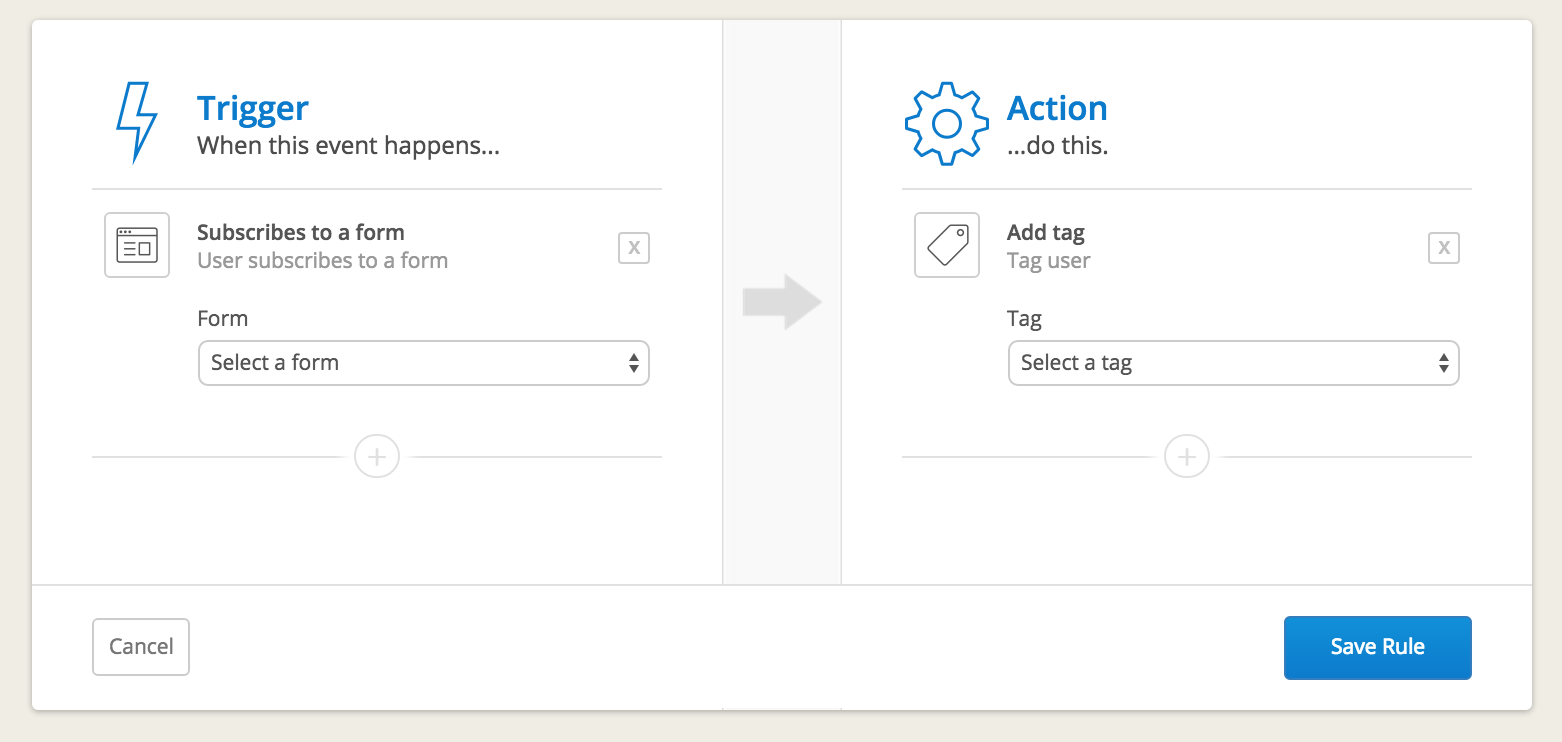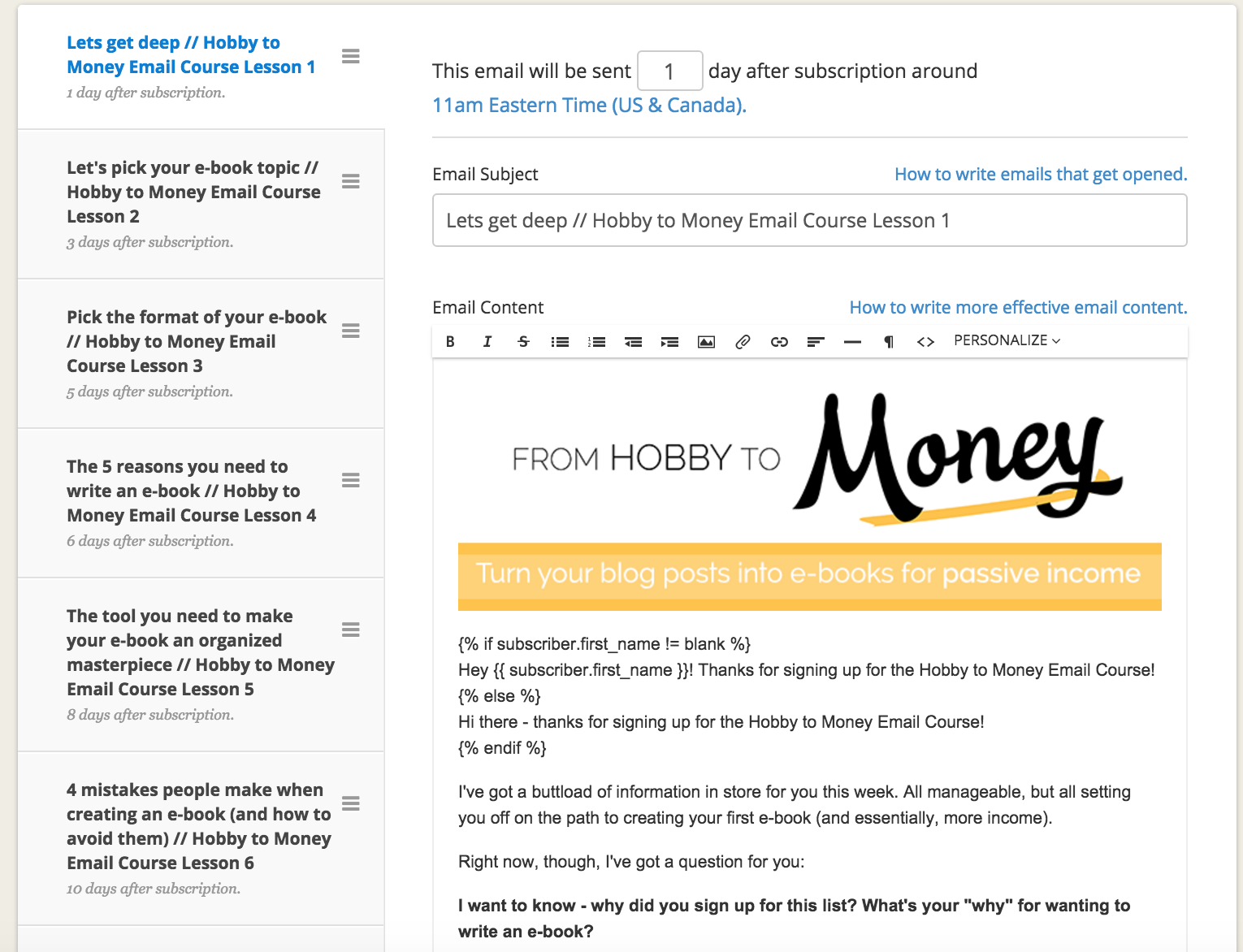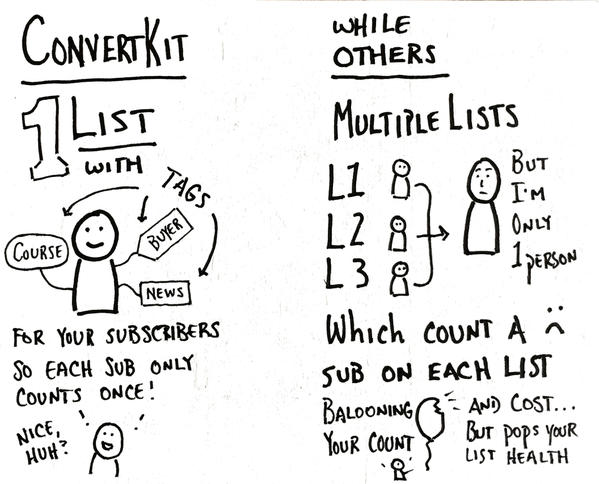Yet another email provider to choose from? Before you get overwhelmed, let me start this post by sharing where I was at when I switched to ConvertKit for my business. I am a one woman shop (hello, fellow ladies!) and was spending more time prepping weekly emails and automation than I really had time for.
Each week, after writing a blog post, I had a series of things to do in order to prep that blog post for a pretty email for my subscribers in MailChimp. I had to take the image I created for my blog, upload it to MailChimp, sometimes resize the image, copy and paste the content into MailChimp, format it, add additional styling (headers, subheaders), and a few other steps that are too boring to mention. And setting up automated email sequences -- a huge part of my marketing plan -- was a time suck, as well.
I wanted something simple that could grow with me as I grow my business. I started hearing a lot about ConvertKit, and decided to make the switch because my number of subscribers had not yet reached a point where it would be a big headache to move to a new platform.
Having used ConvertKit for a while now, here’s the lowdown on why I think it’s great, reasons why it might be a good email service provider for your business, and ways it can be improved.
If this is you, it might be a good idea to switch to ConvertKit...
If your list is on the smaller side now, but you have lofty goals for growing your list. I have big plans for my lists. I’m talking sales funnels, email courses, Twitter ads to bring people in, opt-in forms and landing pages – the works. Each platform may have a different opt-in incentive, meaning that in MailChimp, I would need to make a different list with a different “Welcome email” for each incentive. A few months down the line, list building could get very messy and complicated, especially if I want to merge lists and do some clean up.
ConvertKit has proved to be a stellar option for that, because rather than individual lists, I can tag email addresses for certain categories.
Say a subscriber signs up via an opt-in incentive regarding WordPress design. I can set it up in ConvertKit so that they’re added under the tags “wordpress” and “design” and then when I want to send an email regarding either of those topics, I can pull all subscribers with those tags and send to them, rather than having to send to separate lists (and possibly send duplicate emails).
No more trying to merge lists together or keep track of them – there’s no need. Here’s how I would set that up in ConvertKit:
If you crave automation with your email lists. The gist of ConvertKit is that automated email is way better than individual email “broadcasts.”
Example: You create killer content in June, but Mary doesn’t sign up until August. Instead of missing out on the June content, Mary gets it right from the beginning.
With ConvertKit, if you create an email sequence (aka a funnel), it doesn’t matter when a person signs up - they’ll get emails from months prior, and going forward. No need to set up a specific series, just add in emails as you please, and new subscribers will get all of them in a drip sequence that you determine.
I realize this sounds a lot like Automation in MailChimp, and they are fairly similar, except the set up is much easier in ConvertKit. You stay on the same screen for every email in the sequence, rather than having to click in and out of emails, which can be time-consuming and confusing (“did I include that link in Email 1 or Email 3? I have to click in and out on multiple screens to find out”).
In ConvertKit, it’s all in one place, so you seamlessly move from one email to the next, AND you can rearrange an email sequence via drag and drop -- so easy! Here’s what one of my sequences looks like:
If you plan to create email courses/sales funnels. This is essentially ConvertKit’s bread and butter. In ConvertKit, courses and funnels each fall under the umbrella of "Sequences." Personally, I have a few email courses going -- set up as a Sequence -- and the main purpose of most of these courses is to get people to purchase a product.
In MailChimp, I had something similar, but had to manually remove a person if they bought the product I was promoting. In ConvertKit, if Lisa is in Course A, and she buys the product I’m promoting, the instant she purchases the product, she’ll be switched to Course B, which no longer pushes her to buy the thing she just bought. It makes for a much better user experience, and less work for you.
If you want a very simple opt-in form plugin for your WordPress page. Various email platforms have opt-in forms that you can customize and put on your site, but ConvertKit makes it so dang easy. (And I’m a developer, friends.)
If you have WordPress, they have a plugin where you can insert individual forms at the bottom of blog posts or pages. All of the customization is done in ConvertKit, so there isn’t any need for CSS tweaking on your actual WordPress site to make things look the way you want. (Editor's note: View an example of a form at the bottom of this blog post.)
If you want a nice landing page for sign ups/want to avoid paying for Leadpages. ConvertKit has a few modern and clean landing page designs for opt-in forms. If you want a landing page to entice people to sign up for your email list, ConvertKit makes it really easy to do so. Here’s an example of a landing page for one of my email courses.
Also, prior to switching over to ConvertKit, I purchased Leadpages because I loved the way their forms looked and worked. ConvertKit does integrate with Leadpages, but their landing pages and opt-in forms are so simple and sleek that you can skip Leadpages, and save a hefty buck as well. I think the only thing one would miss from Leadpages is their cool opt-in forms, but it’s worth saving a few hundred buckaroos.
If you’re paying extra money for duplicate subscribers.
Since ConvertKit lets users tag subscribers, rather than place them in lists, it’s impossible to pay for one email address that may be in multiple lists. This happens a lot with Mailchimp, and it can get expensive paying for one person to exist in multiple lists. Here’s a great graphic of how it works, and how it saves you money:
Where ConvertKit excels
Integrates with WordPress, Leadpages, Gumroad (digital product seller), Teachable (online course provider), and so much more. These integrations are what will make your business as seamless as possible for your buyers and clients. And will save you a ton of time because it’s all automated.
Sequences are easy to set up. ConvertKit has a very simple email template -- there isn’t any drag and drop; there’s click and type, and insert an image if you’d like. Because of this, setting up a sequence is pretty dang easy. Bottom line is, if you can use a Word document, you can set up an email in ConvertKit.
Automation rules. You can set up all kinds of rules that work like magic without you doing a thing. Just set it up once, and it’s done. For example, you can set it up so that when someone clicks a specific link, they get subscribed to a sequence, then when they purchase a digital product from that sequence, they’re taken off the list and moved to a different one.
Blog posts to broadcasts. If your WordPress blog is integrated with your ConvertKit account, it automatically creates an email template when you publish a post, and sends you an email notification so you can edit and send. Now, when I want to email a blog post to my list, it’s a two-step process, rather than seven steps (detailed somewhat painfully above!).
Where ConvertKit needs improvement
Clicked links are not tracked in emails individually. I’ve been told this will be changed eventually. At the moment, I can see that people clicked a link in an email, but not specifically which link they clicked on. That’s a bit annoying, but I have faith they’ll change that soon, because they are constantly working to build up their platform integrations and make it more business-friendly.
Sometimes the WYSIWYG editor is buggy. HTML editors can be annoying as it is, but when little bugs pop up while you’re editing an email, it can be even more frustrating. An example would be that recently, the Subscriber Name field that I entered into an email course kept getting wiped out every time I saved.
So instead of “Hi, Stephanie!” at the beginning of an email, if it went out, it would say, “Hi, !” When I get an email with that totally obvious gap between the comma and the exclamation point, it’s like a mini slap in the face. We don’t want that for our subscribers.
ConvertKit is good for your business if:
You’re limited on time. Like anything worthwhile, there is work to be done in the beginning. But once you’ve got your sequences set up, your automation rules in place, and your subscribers tagged, it really is pretty passive and time saving.
You want a very simple email format. The simple format initially made me feel limited, but I like that the focus is on the content of the email, and it looks much more personalized than mass produced, which I’m sure subscribers appreciate as well.
Email is a big part of your marketing plan. Because of the automation and integration, ConvertKit is a huge help in growing a list without a huge headache.
ConvertKit is not good for your business if:
Email is not a big part of your marketing plan. If you’re more into social media or local networking, or really don’t have a marketing plan yet, ConvertKit isn’t for you. It’s $29/month at a minimum (for 1,000 subscribers) and the next level hops to $49/month, so it needs to be a business investment that will be properly utilized.
You like sending emails with a pre-made template or lots of images. Because of the simple WYSIWYG editor, this is not the kind of email provider where you can pick a template and drag and drop images. ConvertKit’s platform is set up to create emails that consist mostly of text, so if your emails tend to be image heavy, this might not be a good fit for you (at least for now). You can create templates that include your logo at the top, and other graphics or design elements, but that requires coding work, so beware.
Easy-to-manage email marketing: Ready to make the switch?
The biggest selling point for ConvertKit is how easy it makes managing email marketing. As business owners, there are a million ways we could spend our time every day.
Switching to ConvertKit has allowed me to spend less time setting up emails and automation, and more time actually working on projects for clients and beefing up other aspects of my business. It keeps things simple and automated, just like our businesses should be!
We are affiliates of and may receive commission from sales of ConvertKit. As always, we only promote products and services that we love and/or think you might benefit from!
Latest posts by Tiffany Breyne (see all)
- Is ConvertKit right for your business? - November 11, 2015












This is such a thorough post. I’m considering making the switch, so this is incredibly rich info for me right now.
Glad it’s helpful, Julienne! Choosing an email service provider is a bigger decision than I think people realize, so hopefully this helps iron out any questions.